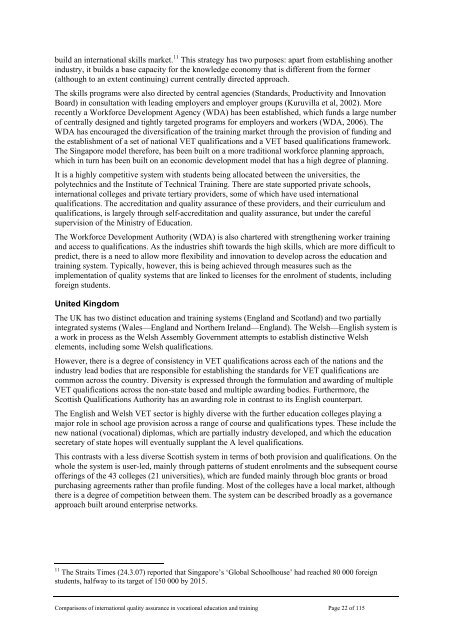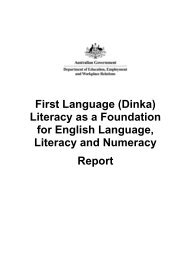Review - Department of Innovation, Industry, Science and Research
Review - Department of Innovation, Industry, Science and Research
Review - Department of Innovation, Industry, Science and Research
Create successful ePaper yourself
Turn your PDF publications into a flip-book with our unique Google optimized e-Paper software.
uild an international skills market. 11 This strategy has two purposes: apart from establishing another<br />
industry, it builds a base capacity for the knowledge economy that is different from the former<br />
(although to an extent continuing) current centrally directed approach.<br />
The skills programs were also directed by central agencies (St<strong>and</strong>ards, Productivity <strong>and</strong> <strong>Innovation</strong><br />
Board) in consultation with leading employers <strong>and</strong> employer groups (Kuruvilla et al, 2002). More<br />
recently a Workforce Development Agency (WDA) has been established, which funds a large number<br />
<strong>of</strong> centrally designed <strong>and</strong> tightly targeted programs for employers <strong>and</strong> workers (WDA, 2006). The<br />
WDA has encouraged the diversification <strong>of</strong> the training market through the provision <strong>of</strong> funding <strong>and</strong><br />
the establishment <strong>of</strong> a set <strong>of</strong> national VET qualifications <strong>and</strong> a VET based qualifications framework.<br />
The Singapore model therefore, has been built on a more traditional workforce planning approach,<br />
which in turn has been built on an economic development model that has a high degree <strong>of</strong> planning.<br />
It is a highly competitive system with students being allocated between the universities, the<br />
polytechnics <strong>and</strong> the Institute <strong>of</strong> Technical Training. There are state supported private schools,<br />
international colleges <strong>and</strong> private tertiary providers, some <strong>of</strong> which have used international<br />
qualifications. The accreditation <strong>and</strong> quality assurance <strong>of</strong> these providers, <strong>and</strong> their curriculum <strong>and</strong><br />
qualifications, is largely through self-accreditation <strong>and</strong> quality assurance, but under the careful<br />
supervision <strong>of</strong> the Ministry <strong>of</strong> Education.<br />
The Workforce Development Authority (WDA) is also chartered with strengthening worker training<br />
<strong>and</strong> access to qualifications. As the industries shift towards the high skills, which are more difficult to<br />
predict, there is a need to allow more flexibility <strong>and</strong> innovation to develop across the education <strong>and</strong><br />
training system. Typically, however, this is being achieved through measures such as the<br />
implementation <strong>of</strong> quality systems that are linked to licenses for the enrolment <strong>of</strong> students, including<br />
foreign students.<br />
United Kingdom<br />
The UK has two distinct education <strong>and</strong> training systems (Engl<strong>and</strong> <strong>and</strong> Scotl<strong>and</strong>) <strong>and</strong> two partially<br />
integrated systems (Wales—Engl<strong>and</strong> <strong>and</strong> Northern Irel<strong>and</strong>—Engl<strong>and</strong>). The Welsh—English system is<br />
a work in process as the Welsh Assembly Government attempts to establish distinctive Welsh<br />
elements, including some Welsh qualifications.<br />
However, there is a degree <strong>of</strong> consistency in VET qualifications across each <strong>of</strong> the nations <strong>and</strong> the<br />
industry lead bodies that are responsible for establishing the st<strong>and</strong>ards for VET qualifications are<br />
common across the country. Diversity is expressed through the formulation <strong>and</strong> awarding <strong>of</strong> multiple<br />
VET qualifications across the non-state based <strong>and</strong> multiple awarding bodies. Furthermore, the<br />
Scottish Qualifications Authority has an awarding role in contrast to its English counterpart.<br />
The English <strong>and</strong> Welsh VET sector is highly diverse with the further education colleges playing a<br />
major role in school age provision across a range <strong>of</strong> course <strong>and</strong> qualifications types. These include the<br />
new national (vocational) diplomas, which are partially industry developed, <strong>and</strong> which the education<br />
secretary <strong>of</strong> state hopes will eventually supplant the A level qualifications.<br />
This contrasts with a less diverse Scottish system in terms <strong>of</strong> both provision <strong>and</strong> qualifications. On the<br />
whole the system is user-led, mainly through patterns <strong>of</strong> student enrolments <strong>and</strong> the subsequent course<br />
<strong>of</strong>ferings <strong>of</strong> the 43 colleges (21 universities), which are funded mainly through bloc grants or broad<br />
purchasing agreements rather than pr<strong>of</strong>ile funding. Most <strong>of</strong> the colleges have a local market, although<br />
there is a degree <strong>of</strong> competition between them. The system can be described broadly as a governance<br />
approach built around enterprise networks.<br />
11 The Straits Times (24.3.07) reported that Singapore’s ‘Global Schoolhouse’ had reached 80 000 foreign<br />
students, halfway to its target <strong>of</strong> 150 000 by 2015.<br />
Comparisons <strong>of</strong> international quality assurance in vocational education <strong>and</strong> training Page 22 <strong>of</strong> 115
















